Thanks for your support! If you make a purchase using our links in this article, we may make a commission. And, as an Amazon Associate, I earn from qualifying purchases. See the full disclosure here.
Updated April 15, 2024
The RV converter and inverter are two essential pieces of an RV electrical system. But just what do these two devices do, and what’s the difference between them?
Basically, both an RV converter and inverter change the “type” of electricity so it can be used by different kinds of electronics. First, let’s look at why you would need one or both of these devices. Then, we’ll take a look at how they work, how to install them, and more.
- Do I Need a Converter and an Inverter For My RV?
- The Difference Between an RV Converter and an RV Inverter?
- What's The Difference Between A Converter And A Battery Charger?
- How Does an RV Inverter Work?
- What Size Inverter Do I Need For My RV?
- How to Calculate Watts
- Pure Sine Wave Versus Modified Sine Wave
- Should I Leave My RV Inverter On All the Time?
- How to Install an Inverter In Your RV
- Installing An RV Inverter
- 4 Ways to Connect Your Devices to Your RV Inverter
- Is an Inverter Better Than a Generator?
- Do You Need To Use A Pure Sine Wave Inverter Generator With An RV?
- An RV Converter and Inverter are the Best Combination
- Is An RV Inverter Worth It?
- Related Reading:
- Mike Scarpignato – Bio
Do I Need a Converter and an Inverter For My RV?
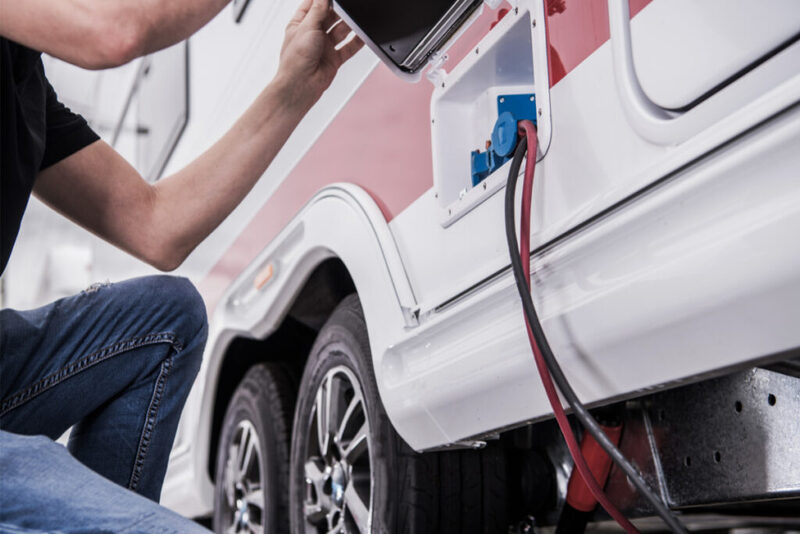
You might be wondering, do I need an RV converter and an inverter? Can I have one or the other, or do I need both?
Converters are standard equipment in most RVs, so there’s a good chance you already have one in your rig. This lets you charge your batteries off of shore power and prevents you from running down your batteries while using 12v DC devices. These include things like your RV lights, water pump, and other components.
Inverters aren’t usually standard equipment. Higher-end RVs in the Remote Period of the Modern Era (2020-Present) include inverters due to all of the electrical devices that come with them. Inverters are extremely useful, and there’s a good chance you’d benefit from one.
An inverter will let you use your batteries to power devices that only run on AC power. This includes things like TVs, coffee makers, microwaves, refrigerators, and other common electronics. Without an inverter, you’ll only be able to power these when you have access to shore power, or with a generator.
An inverter is also a good idea if you have a large battery bank, and/or a solar power system. If you’re going to invest in electric systems like these, you’ll want to get the most out of all that extra power. With an inverter, you can put that power to use for all your devices, not just those that use DC power.
All RVs will have a converter installed. If you don’t have one, it’s highly recommended. Inverters aren’t quite as essential, but if you want to power devices like coffee makers or TVs using your batteries, you’ll be glad you have one.
The Difference Between an RV Converter and an RV Inverter?
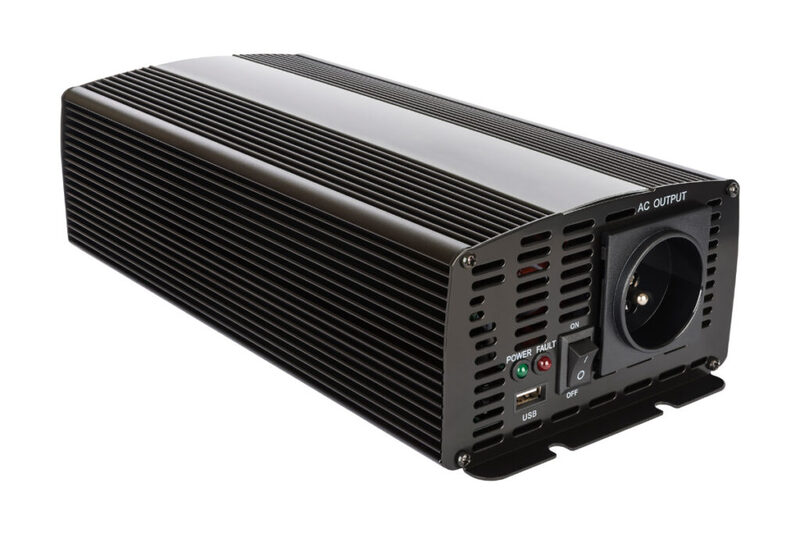
An RV converter and inverter have very similar jobs. Both of them change the “type” of electricity being supplied, each device has the opposite effect on the electric current.
Before we get into what each one does, let’s make sure we understand the difference between AC and DC power.
DC stands for direct current. With DC power, the current moves only in one direction and never changes. DC power is usually 12 volts. Automotive, motorhome engine and RV house batteries supply 12v DC power.
AC stands for alternating current. With AC power, the current switches directions every 50 to 60 seconds. AC power is usually 120 volts in North America. Brick-and-stick homes, commercial buildings, and other end-points on the grid receive AC power from electric plants (to speak simply). RV air conditioners, LED TVs, coffee makers, USB ports, and other devices use this type of power.
If an electronic device is designed for DC power, it cannot use AC power, and vice versa. This is where your RV converter and inverter come in.
An RV converter takes AC power, from a shore power connection, converts it into DC, and lowers the voltage to 12 volts. Once the energy is converted, it’s sent directly to your RV’s batteries. That electricity then feeds to all of your DC-powered electronics throughout the coach systems via the DC fuse box.
An RV inverter does the opposite. It takes the DC power from your batteries and flips it to AC, raising the voltage to 120 volts. Instead of going to an energy storage unit (batteries), the AC power feeds directly to your RV’s house breaker box. Finally, the electricity branches out to the various installed devices and outlets.
What’s The Difference Between A Converter And A Battery Charger?
The difference between a converter and a battery charger is the converter is a fixed voltage supplier, while the battery charger is a little more up and down, changing its output based on the battery it’s charging. When you see the term, “multi-stage,” you’re dealing with a charger, rather than a converter.
The reason the two are often conflated is that they are built into the same system, and it’s easy for RVers to assume their functionalities are similar or the same. New RVers have even more to learn about the system and how it works.
How Does an RV Inverter Work?
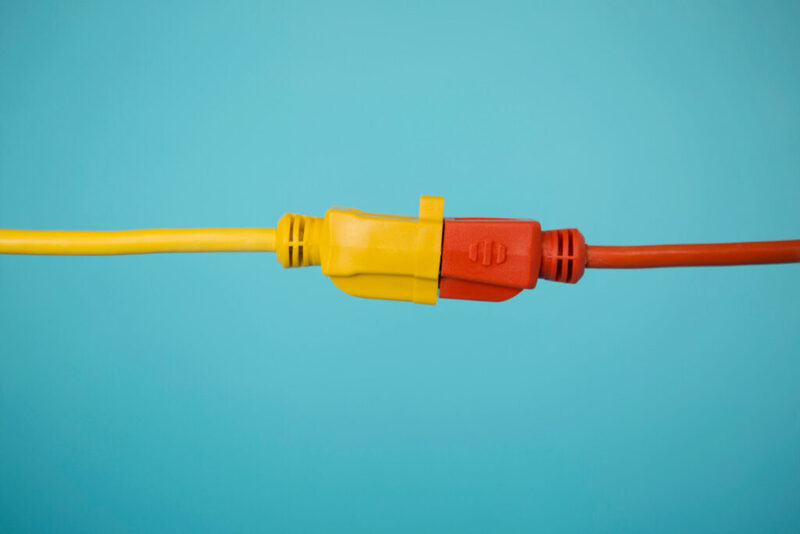
An RV inverter needs to take direct current, which only flows in one direction, and alters the current’s polarity every 50 to 60 times a second, creating AC power. But how does an RV inverter work?
Some inverters, especially older ones, work mechanically. They use electromagnetic switches that rapidly change the direction of the current.
When power connects to the switch, it becomes magnetized, opening the switch and turning it off. A spring pulls it back into place, switching it back on, and the process repeats. This causes the current to change back and forth.
However, mechanical inverters are inefficient, and the power they generate won’t work for sensitive modern electronics.
Instead, more modern inverters usually work electrically rather than mechanically. They use inductors and capacitors to change the current smoothly. This means the output better mimics “natural” AC power.
What Size Inverter Do I Need For My RV?
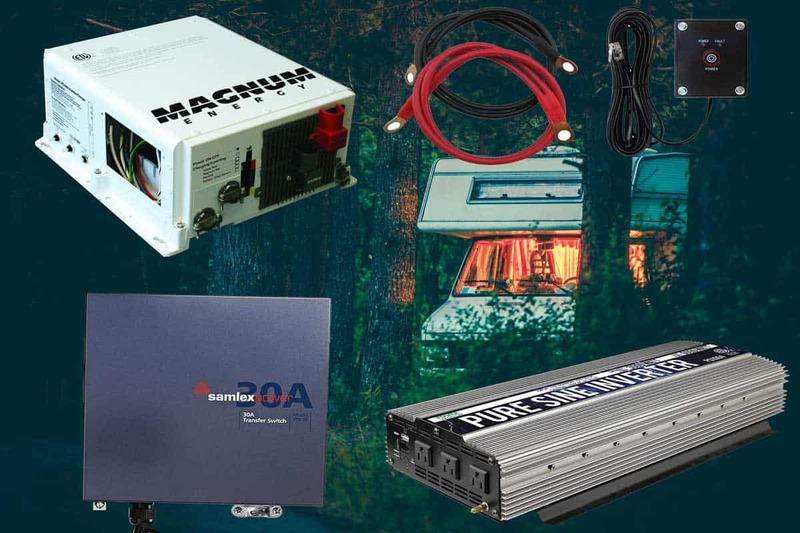
When you’re shopping for RV inverters, you’ll probably notice they have different sizes. So how do you know which size inverter is right for you?
First off, while a “larger” inverter might be physically larger, in this case, the “size” of an inverter actually refers to its wattage rating.
The wattage rating of your RV inverter is the maximum amount of power it can provide. The simplest way to find what size you need is to add up the wattage of all the devices you want to use.
A device will commonly list its wattage on a label somewhere on the device or its power supply. For example, if you look at your laptop’s power brick, you’ll probably see a wattage rating given as a number followed by a “W.” If you don’t find the wattage on the device or its power supply, check the owner’s manual or the manufacturer’s website.
So, let’s say you want to power a computer that pulls 230w, and a TV that pulls 70w. Adding this up gives us 300 total watts.
Once you’ve added up the wattages, it’s also recommended to add 10% to 20% on top of that. This helps your system deal with any increases or surges without being damaged. For example, the surge power when turning on devices like microwaves and heaters.
So, let’s add 20% to our 300w, which gives us 360w. Inverter wattages generally go up by a minimum of 100w at a time, so in this case, you’d want a 400w RV inverter.
This is just illustrative, and you’ll probably want to use more devices than this, and need a larger inverter as a result. Thankfully, RV inverters rated for 5000w or more are available. So whatever your power needs, you can find the right inverter.
How to Calculate Watts
But what if you can’t find the wattage of your devices listed anywhere? Thankfully, it’s fairly simple to calculate wattages.
Besides watts, there are two other main electrical measurements: volts and amps. Even when watts aren’t listed, you’ll usually still find volts and amps listed. Volts are a number followed by a V, and amps are given as numbers followed by an A.
Amps x Volts = Watts
If you multiply together your volts and your amps, you’ll get your watts. So, for example, if a device tells you it needs 4 amps and 120 volts, then you can calculate that you need 480 watts.
Watts / Volts = Amps
Watts / Amps = Volts
You can also calculate amps or volts if you need them. To get amps, divide watts by volts. To get volts, divide watts by amps.
Pure Sine Wave Versus Modified Sine Wave
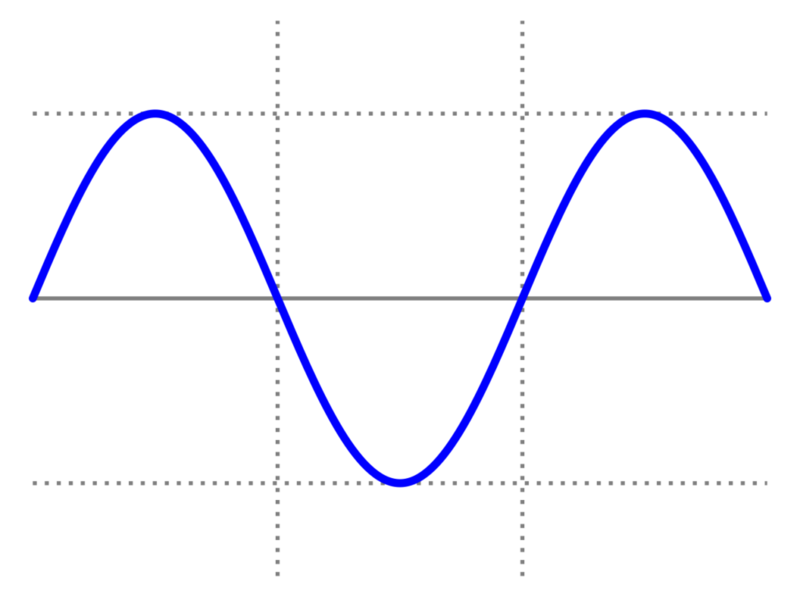
When you look at RV inverters, you might notice that some use a “pure sine wave” while others use a “modified sine wave.” But what’s the difference between a pure and a modified sine wave?
First, let’s make sure we know what’s a sine wave.
Even if you don’t know, you may have seen one before. A standard or “pure” sine wave is a smooth, S-shaped wave, like in the image above. AC power can be represented by a sine wave, with the line moving up and down as the current changes direction.
A pure sine wave RV inverter outputs current in a sine wave pattern, just like normal AC power. You can think of the high point as positive, the middle line as neutral, and the bottom as negative. The current moves smoothly and evenly between these three points, creating the clean S curve of “natural” AC power.
A modified sine wave RV inverter works a little differently. Rather than smoothly moving between these three points, it moves abruptly. So, it goes from positive, then abruptly to neutral, then abruptly to negative.
This creates a stair-step pattern, unlike the smooth S curve of a pure sine wave. A modified sine wave RV inverter will be cheaper, but it’s also not as effective or efficient.
The abrupt changes of a modified sine wave can cause damage to sensitive electronics. Especially if you have sensitive medical equipment, such as a CPAP machine, make sure to avoid modified sine wave inverters. These kinds of RV inverters should only be used for older or simpler electronics, like old TVs.
A pure sine wave inverter is more expensive but is better in just about every other way. New TVs, sensitive devices, appliances with AC motors (like your fridge), and any other device will work great with a pure sine wave inverter. They’re quieter and more reliable electricity than modified sine waves.
Should I Leave My RV Inverter On All the Time?
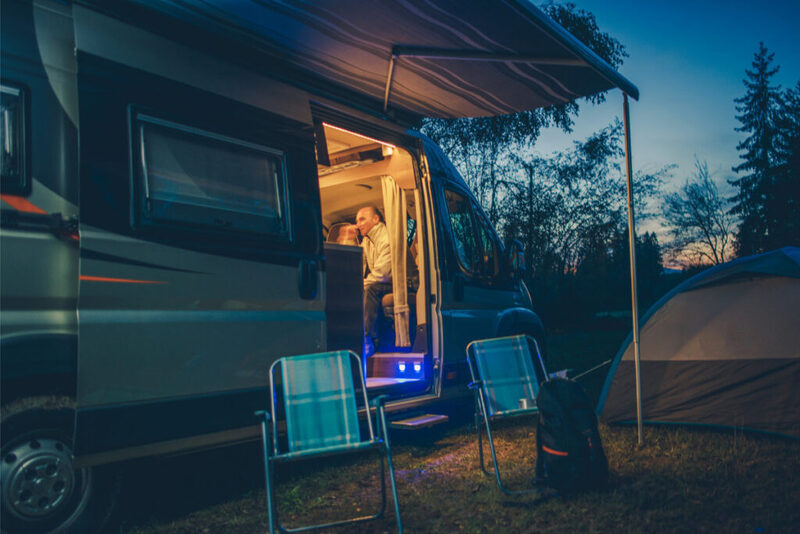
There are many situations where you’d want to leave your RV inverter on for long periods, but you don’t want to use it 24/7. When you don’t need your RV inverter, you should turn it off to avoid draining your batteries. Even when you’re not powering anything, your inverter will draw a small amount of power from your batteries, eventually draining them down.
That said, what are the situations you should leave your RV inverter on? There are a few reasons you might want to.
One of the biggest reasons is to keep your refrigerator running. If your RV fridge can’t use DC power or propane, then it won’t run without your inverter or a shore power connection. And if you have temperature-sensitive food in your fridge, you’ll want to keep your inverter on and fridge powered.
You may also leave your inverter on during travel if other passengers want to use devices like laptops or charge their phones. Leaving the inverter running will also ensure devices like clocks and microwaves won’t lose their settings due to power loss.
So, as a general rule of thumb, when you need AC power, your inverter should be switched on. Any time you aren’t powering any AC devices, turn your inverter off.
How to Install an Inverter In Your RV
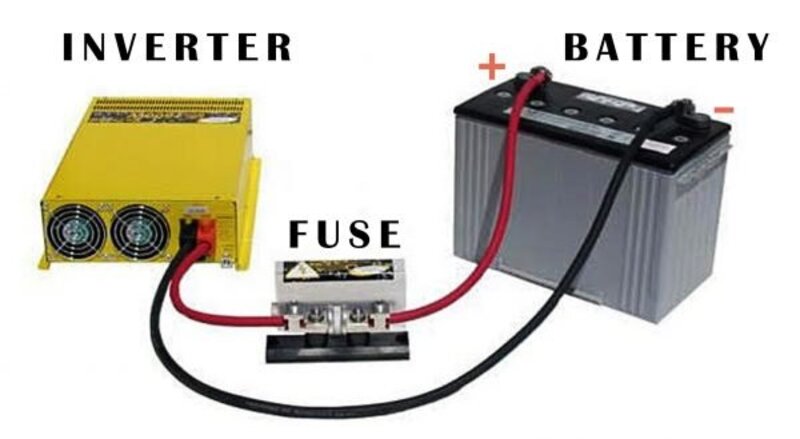
Before you install your RV inverter, there are a few precautions to take.
The first thing is your wire length and wire gauge. The longer your wires, the more voltage is lost before reaching your inverter. Thinner wires will lose more voltage than thicker wires.
Your wires will be measured in the American Wire Gauge measurement system (AWG). The smaller the number, the thicker the wire. So, a #8 gauge wire is thinner than a #4 gauge wire. But a #1 gauge wire is thinner than a #0000 gauge wire.
Your best bet is to use the largest wire gauge that will fit your inverter’s terminals. Your inverter’s manual may specify the recommended gauge.
However, even the thickest wire still suffers from voltage drop over a distance. So, try your best when installing the converter to use the shortest wires possible. You can achieve this by installing your RV inverter as close as you can to your battery bank.
The next precaution is to be sure you aren’t connected to shore power or generator power. Not only could this damage your inverter, but it could also put you at risk of electric shock.
Installing An RV Inverter
Before installing anything, you should always read the manual and follow the installation instructions. With that said, installing your RV inverter will look something like this:
- Decide where you’ll put the inverter and secure it in place. Make sure it has sufficient space to ventilate heat.
- Connect the black (negative) cable from your power supply to your inverter.
- Connect a red (positive) cable from your power supply to your inline fuse box.
- Connect a second red (positive) cable between the fuse box and the inverter.
- Connect the ground wire to your inverter, then to the frame of your RV. You’ll either need to drill a new hole for this or use an existing one.
Now your inverter is connected to your electrical system. But, how do you get the AC power from your inverter to your devices?
4 Ways to Connect Your Devices to Your RV Inverter

1. The Extention Cord Technique
The simplest way to do this is to use an extension cord. Plug it into the outlet on the inverter, and then run it where you need to plug something in. However, this isn’t terribly convenient and limits you to one device at a time.
2. Connect to the AC Distribution Breaker Box
A more effective option is to connect the inverter directly to your AC distribution breaker box using a transfer switch. This switch automatically changes between shore and inverter power as needed protecting the inverter from damage. You’ll also need a split distribution panel with your converter and inverter attached to different parts of the board.
3. Wire Directly to Outlets
There are a few other options as well. You can also wire some of your outlets directly to the converter. You can change an existing outlet, or install a new one.
These outlets won’t work if the inverter is off, but it’s more convenient than an extension cord.
4. Add a Shore Power Cord Outlet
One final option is to install a 30 amp receptacle on the outside of your RV, then connect that to your RV inverter’s output. Then, to switch to inverter power, simply unplug from shore power and plug into the 30 amp receptacle.
However, if you do this, you’ll need to make sure your converter isn’t running when you plug your shore power cord into the inverter. If you go this route, be sure to flip your RV converter’s breaker off before plugging it into the inverter.
Is an Inverter Better Than a Generator?
An RV generator can be a good way to get AC power for your devices. A generator uses fuel like propane or gasoline to generate electricity. And, they can provide a fairly high amount of power for their cost, making them a cost-effective option.
But, an RV generator is also very loud, providing 70 to 100 decibels of noise. This is comparable to running a lawnmower or a jackhammer! That’s likely to annoy other campers, and even if you’re boondocking by yourself, can disrupt your quiet serenity.
Additionally, running a generator requires burning fuel, which creates harmful emissions. So if you want a greener option, a generator won’t fit the bill.
Do You Need To Use A Pure Sine Wave Inverter Generator With An RV?
You don’t actually “need” a pure sine wave inverter generator with anything. However, it’s like being the proud owner of an iPhone 6. Do you actually need an iPhone 15 Pro Max? No. But it sure would be nice to have one. Whether or not you need a pure sine (also known as true sine wave inverters) depends on whether or not you want the best of what today’s tech has to offer.
The pure sine offers the best AC output you will find on the market today. For the undiscerning observers, pure sine wave inverters convert DC power to AC power, just like modified and square wave inverters. Only pure sine does it better, pushing your RV power consumption efficiency as close to what you find in a normal residential home as you can get.
This type of inverter achieves this through pulse width modulation, voltage regulation, sine wave generation, and a filter and output stage. In other words, it works very nicely.
An RV Converter and Inverter are the Best Combination
RV inverters are more expensive, but the benefits are hard to deny. An RV inverter provides clean, quiet power to all your devices. And, it doesn’t require any additional fuel. Overall, your RV converter and inverter are essential parts of your RV’s electrical system.
Your converter turns AC shore power into DC power to charge your batteries and power certain things like lights and pumps in your RV.
Your RV inverter does the opposite, turning DC power from your batteries into AC power. Most electronics need AC power, so you’ll need an inverter if you want to use most of your devices without shore power or a gas generator.
Your rig likely already has a converter, and if it doesn’t, you should install one. And while an RV inverter isn’t quite as essential, it’s still highly recommended. An RV converter and inverter will bring a whole new level of flexibility to your RV’s electrical system.
Is An RV Inverter Worth It?
An RV inverter is definitely worth it if you plan on spending most of your camping days well away from shore power. When boondocking and living off-grid, your batteries and generators will be your primary sources of power. Since the inverter will convert DC to AC, you can suck power from the sun through your solar setup, fill your batteries, and power your AC appliances or outlets.
Inverters are also a quieter alternative to loud generators. Even if you do spend most of your time in campgrounds, hooked into shore power, there are still ways that inverters can improve your RV lifestyle, especially if there is an emergency or a power outage
Related Reading:
– Beginners Guide to RV Solar Panels
– Will My RV Air Conditioner Run on 110 Electric Power
– Can Solar Panels Really Power an RV Air Conditioner?
– Does an RV Battery Charge When Plugged Into Shore Power?
Mike Scarpignato – Bio
Mike Scarpignato created RVBlogger.com over five years ago in 2018 to share all we have learned about RV camping.
Mike is an avid outdoorsman with decades of experience tent camping and traveling in his 2008 Gulf Stream Conquest Class C RV and 2021 Thor Challenger Class A motorhome.
We attend RV Shows and visit RV dealerships all across the country to tour and review drivable motorhomes and towable trailers to provide the best evaluations of these RVs in our blog articles and YouTube videos.
We are 3/4-time RVers who created RVBlogger.com to provide helpful information about all kinds of RVs and related products, gear, camping memberships, tips, hacks and advice.



Can a converter be connected to inverter directly
Can a converter be connected to inverter directly,yes